Product Images Leflunomide
View Photos of Packaging, Labels & Appearance
- chemical-structure-description - chemical structure description
- chemical-structure-pharmacokinetics - chemical structure pharmacoki
- company logo - company logo
- Container Label - 10 mg - container label 10mg
- Container Label - 20 mg - container label 20mg
- Figure 1 - figure 1
- Figure 2 - figure 2
- Figure 3 - figure 3
- Figure 4 - figure 4
- how supplied - how supplied
- Table 1 - table 1
- Table 2 - table 2
- Table 3 - table 3
- Table 4 - table 4
Product Label Images
The following 14 images provide visual information about the product associated with Leflunomide NDC 10702-278 by Kvk-tech, Inc., such as packaging, labeling, and the appearance of the drug itself. This resource could be helpful for medical professionals, pharmacists, and patients seeking to verify medication information and ensure they have the correct product.
Container Label - 10 mg - container label 10mg
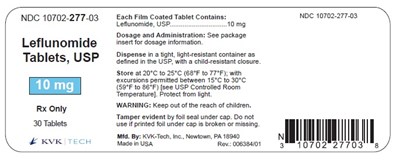
This is a medication called Leflunomide in tablet form with an NDC number of 10702-277-03. It is available with a prescription and each tablet contains 10mg of Lefunomide, USP. Dosage and administration instructions are available in the package insert. The medication should be stored in a tight, light-resistant container and protected from light, with a child-resistant closure. It must be kept away from children, and if the printed foil under the cap is broken or missing, it should not be used. It is manufactured by KVK-Toch, Inc. in Newlown, PA.*
Container Label - 20 mg - container label 20mg
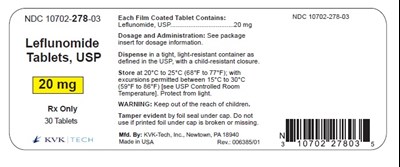
Description: Leflunomide is a prescription drug available in the form of film-coated tablets. Each tablet contains 20 mg of Lefunomide, USP. The package insert provides dosage information. Dispense in a tight, light-resistant container as defined in the USP, with a child-resistant closure. The drug should be stored at temperatures between 20°C to 25°C (68°F to 77°F), with permissible excursions between 15°C to 30°C (59°F to 86°F). The drug may cause harm if swallowed by children, hence, keep it out of their reach. The drug is manufactured by KVK-Tech Inc, Nowlown, PA.*
Figure 1 - figure 1
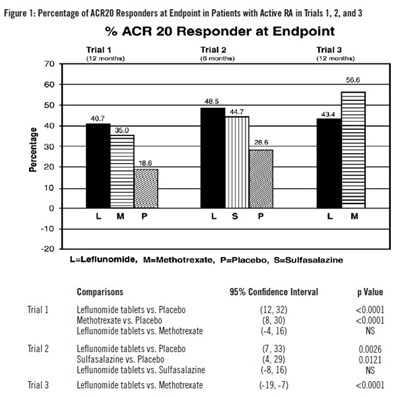
This is a table describing the percentage of ACR20 responders in patients with active rheumatoid arthritis in three clinical trials. The table provides information on the comparison between different drugs, such as Leflunomide, Methotrexate, and sulfasalazine, and placebo. The comparison is based on the percentage of responders, with trial durations ranging from 12 to 24 months. The table also includes 95% confidence intervals and p-values for each drug comparison.*
Figure 2 - figure 2
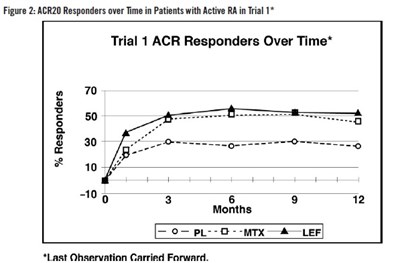
The text is a part of a chart in a medical study related to the response of patients with active rheumatoid arthritis over a period of 12 months. The chart displays the percentage of patients who showed ACR20 response over 6 months of treatment with a combination of MTX and LEF. The data is based on trial 1 and the last observation was carried forward.*
Figure 3 - figure 3
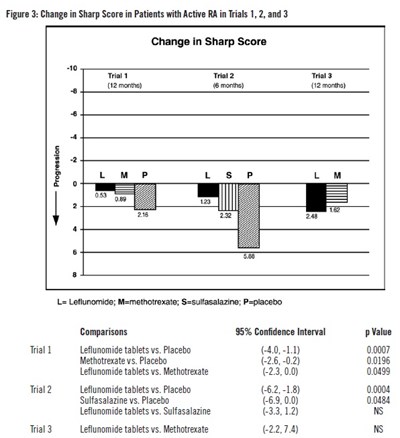
This is a graphical representation of the change in Sharp Score in patients with active RA in Trials 1, 2, and 3. The trials include patients who were given Leflunomide, Methotrexate, Sulfasalazine, or placebo. The text also shows comparisons and 95% confidence intervals between the different treatments.*
Figure 4 - figure 4
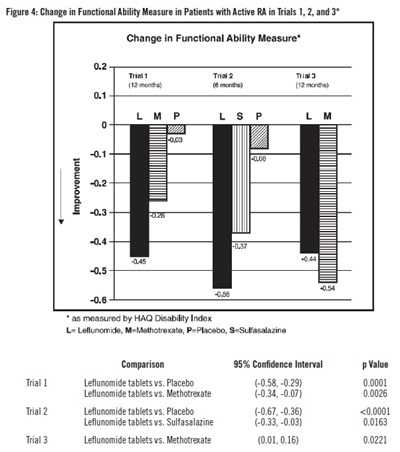
This is a graph with three lines representing the change in functional ability measure in patients with active rheumatoid arthritis in three different trials. The change is measured by the HAQ Disability Index. The graph also includes a comparison chart showing the 95% confidence interval and p-value of each trial comparing Leflunomide tablets to Placebo, Methotrexate, or Sulfasalazine.*
how supplied - how supplied

This is a product description of two strength variations of a medication. The first strength is 10mg and is available in a 30 count bottle with NDC number 10702-277-03. The tablet is white, round, film-coated, biconvex, and debossed with "V55" on one side and plain on the other side. The second strength is 20mg and is available in a 30 count bottle with NDC number 10702-278:03. The tablet is yellow, triangular, film-coated, biconvex, and debossed with "V56" on one side and plain on the other side.*
Table 1 - table 1
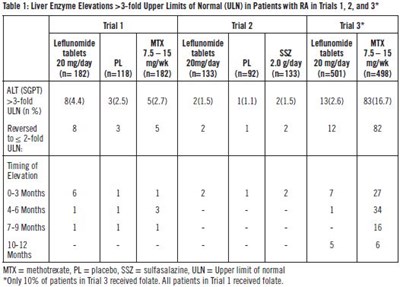
This is a table showing liver enzyme elevations in patients with rheumatoid arthritis in clinical trials 1, 2, and 3. The table compares the effects of Lefunomide and Placebo in the trials. The table lists the dosage, number of patients with enzyme elevations, and timing of the elevations. The table also notes that only 10% of patients in Trial 3 received folate supplementation.*
Table 2 - table 2
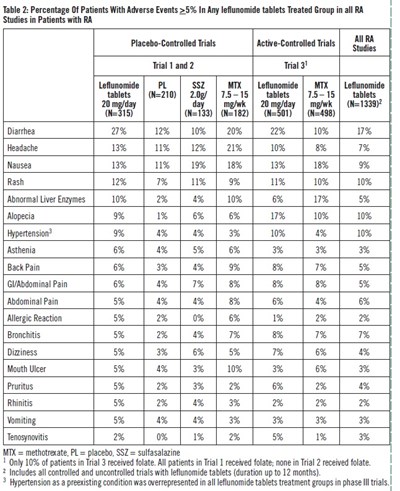
This is a table that shows the percentage of patients who experienced adverse events when taking leflunomide tablets in trials for rheumatoid arthritis. The table includes the placebo-controlled and active-controlled trials. Adverse events include diarrhea, headache, nausea, rash, abnormal liver enzymes, alopecia, hypertension, asthenia, back pain, abdominal pain, allergic reaction, bronchitis, dizziness, mouth ulcer, pruritus, rhinitis, vomiting, and tenosynovitis. The text also includes additional information about the trials and patient demographics.*
Table 3 - table 3
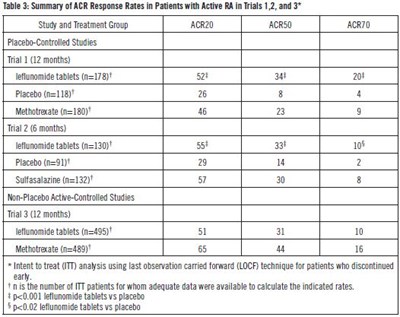
This is a summary table showing the response rates of patients with active RA in three different trials. The response rates were measured using the ACR20, ACR50, and ACR70 criteria. The first two studies were placebo-controlled and the third one was an active-controlled study. The intention-to-treat analysis was used, and the LOCF technique was applied for patients who discontinued early. The table also shows the number of patients for whom adequate data were available to calculate the indicated rates. There were significant differences between the response rates of patients taking leflunomide tablets vs placebo.*
Table 4 - table 4
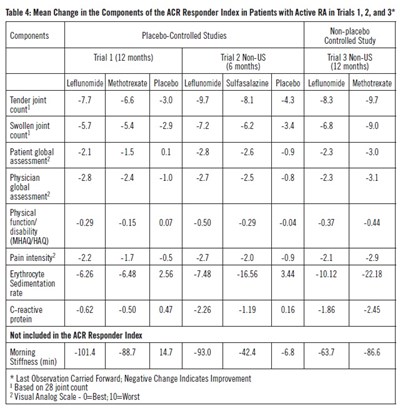
The text describes the mean change in components of the ACR Responder Index in patients with active Rheumatoid Arthritis (RA) in different trials based on observation carried forward. The table shows the results of the placebo-controlled studies with different medications and the difference in tender joint count, swollen joint count, patient and physician global assessment, physical function/disability, pain intensity, erythrocyte sedimentation rate, and C-reactive protein. The table also indicates that negative change indicates improvement, and the scale used was based on 28 joint counts and visual analog scale where 0 is best, and 10 is worst.*
* The product label images have been analyzed using a combination of traditional computing and machine learning techniques. It should be noted that the descriptions provided may not be entirely accurate as they are experimental in nature. Use the information in this page at your own discretion and risk.


